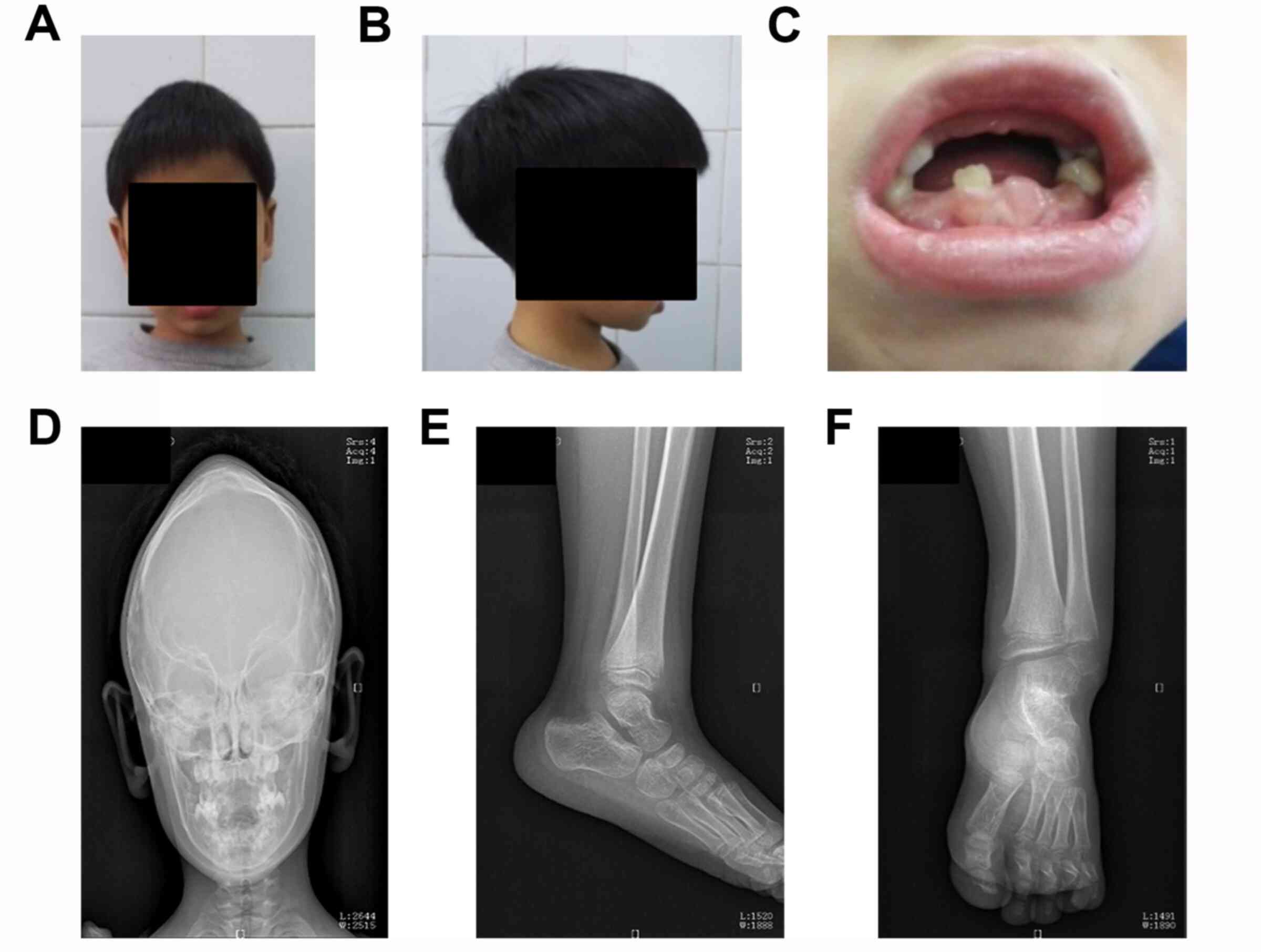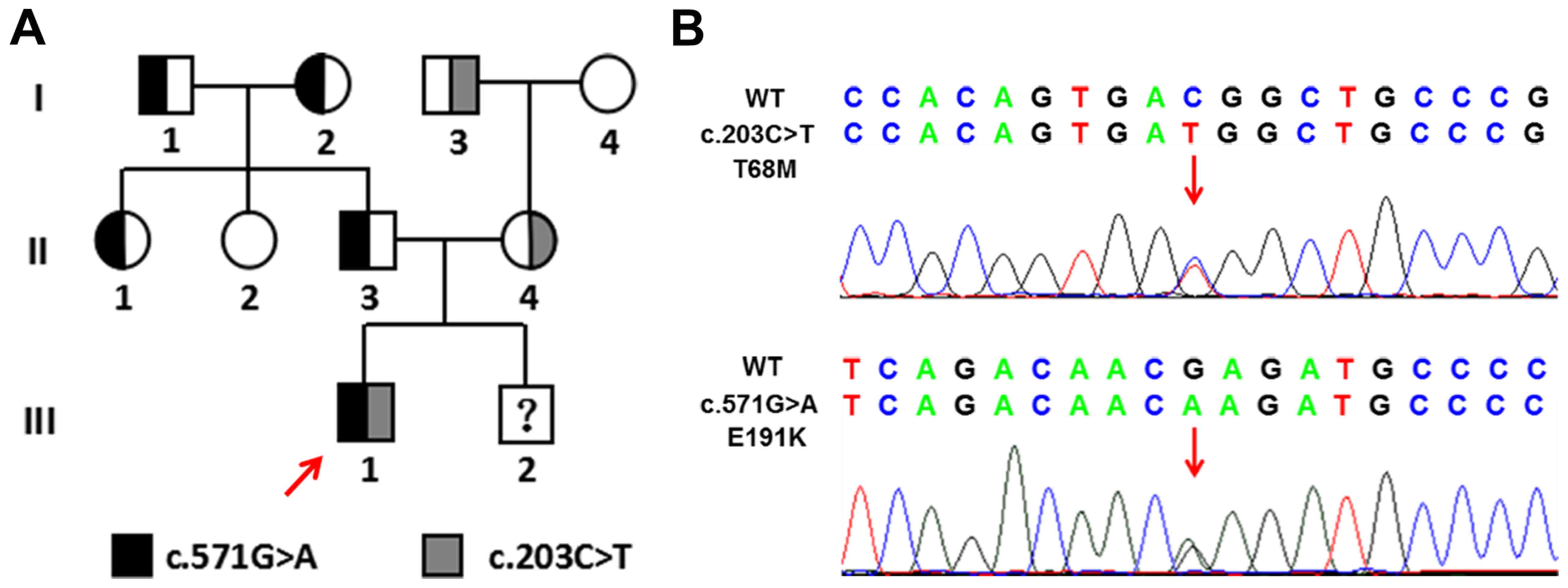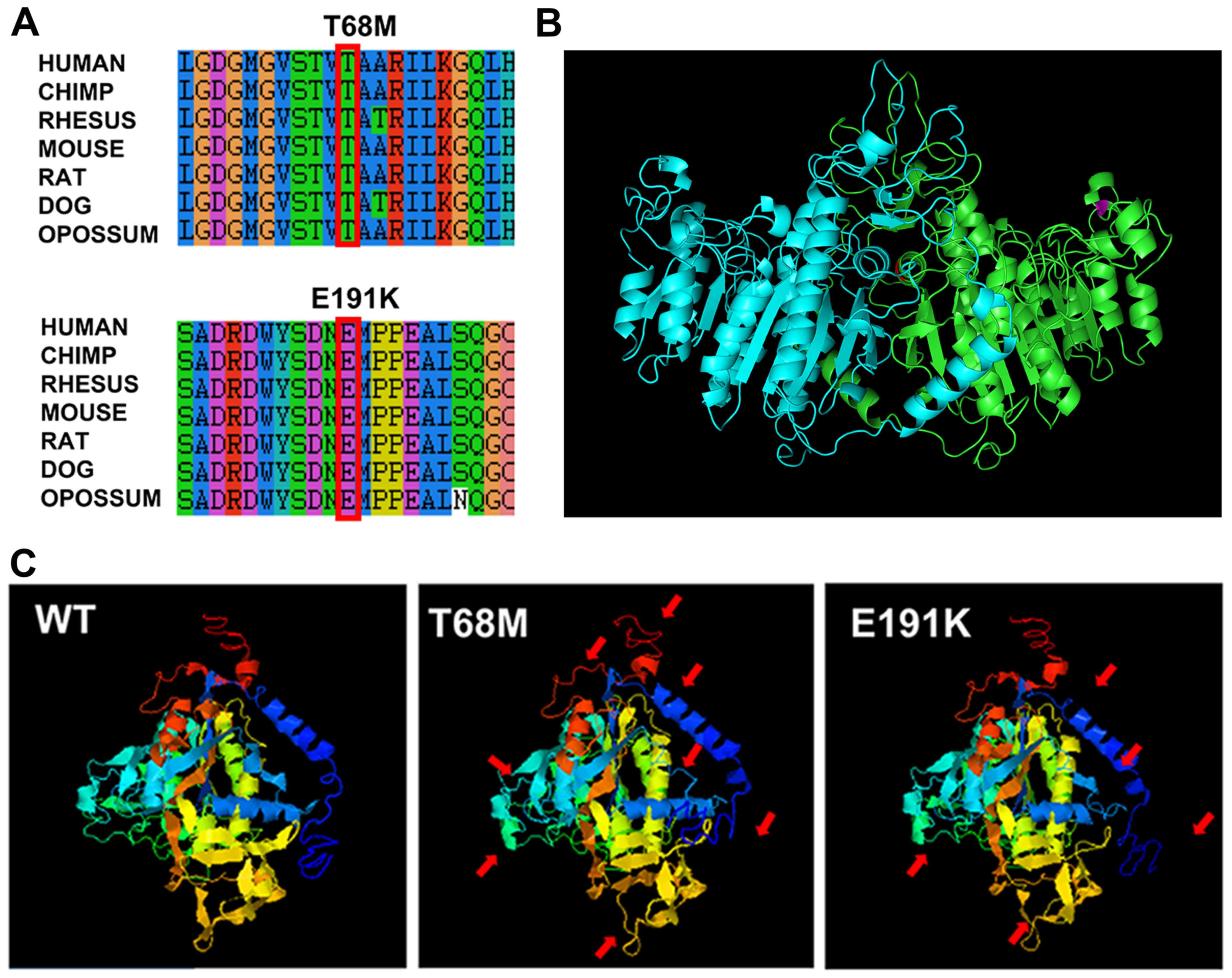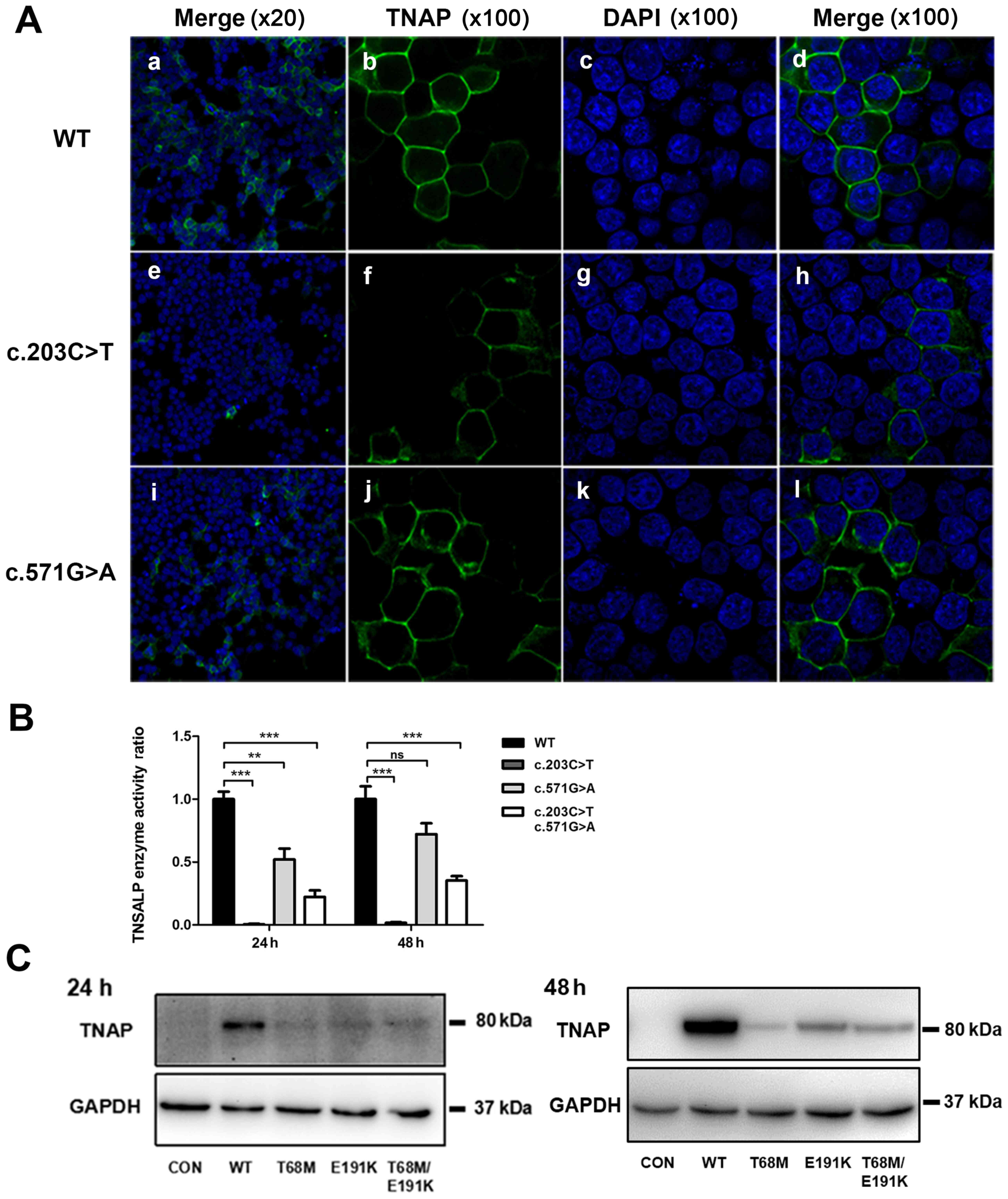|
1
|
Rathbun JC: Hypophosphatasia; a new
developmental anomaly. Am J Dis Child. 75:822–831. 1948.PubMed/NCBI View Article : Google Scholar
|
|
2
|
Orton NC, Innes AM, Chudley AE and
Bech-Hansen NT: Unique disease heritage of the dutch-german
mennonite population. Am J Med Genet A. 146A:1072–1087.
2008.PubMed/NCBI View Article : Google Scholar
|
|
3
|
Greenberg CR, Evans JA, McKendry-Smith S,
Redekopp S, Haworth JC, Mulivor R and Chodirker BN: Infantile
hypophosphatasia: Localization within chromosome region 1p36.1-34
and prenatal diagnosis using linked DNA markers. Am J Hum Genet.
46:286–292. 1990.PubMed/NCBI
|
|
4
|
Mornet E, Yvard A, Taillandier A, Fauvert
D and Simon-Bouy B: A molecular-based estimation of the prevalence
of hypophosphatasia in the European population. Ann Hum Genet.
75:439–445. 2011.PubMed/NCBI View Article : Google Scholar
|
|
5
|
Mornet E: Hypophosphatasia. Orphanet J
Rare Dis. 2(40)2007.PubMed/NCBI View Article : Google Scholar
|
|
6
|
Whyte MP: Genetics of Bone Biology and
Skeletal Disease. Thakker RV, Whyte MP, Eisman J, Igarashi T
(eds.). 1st edition.Academic Press pp337-360, 2012.
|
|
7
|
Whyte MP, Zhang F, Wenkert D, McAlister
WH, Mack KE, Benigno MC, Coburn SP, Wagy S, Griffin DM, Ericson KL
and Mumm S: Hypophosphatasia: Validation and expansion of the
clinical nosology for children from 25 years experience with 173
pediatric patients. Bone. 75:229–239. 2015.PubMed/NCBI View Article : Google Scholar
|
|
8
|
Mornet E and Nunes ME: Hypophosphatasia.
In: GeneReviews®. Adam MP, Ardinger HH, Pagon RA, et
al (eds.). Seattle (WA): University of Washington, Seattle,
1993-2020.
|
|
9
|
Silver MM, Vilos GA and Milne KJ:
Pulmonary hypoplasia in neonatal hypophosphatasia. Pediatr Pathol.
8:483–493. 1988.PubMed/NCBI View Article : Google Scholar
|
|
10
|
Wenkert D, McAlister WH, Coburn SP, Zerega
JA, Ryan LM, Ericson KL, Hersh JH, Mumm S and Whyte MP:
Hypophosphatasia: Non-lethal disease despite skeletal presentation
in utero (17 new cases and literature review). J Bone Miner Res.
26:2389–2398. 2011.PubMed/NCBI View
Article : Google Scholar
|
|
11
|
Fraser D: Hypophosphatasia. Am J Med.
22:730–746. 1957.PubMed/NCBI View Article : Google Scholar
|
|
12
|
Whyte MP, Greenberg CR, Salman NJ, Bober
MB, McAlister WH, Wenkert D, Van Sickle BJ, Simmons JH, Edgar TS,
Bauer ML, et al: Enzyme-replacement therapy in life-threatening
hypophosphatasia. N Engl J Med. 366:904–913. 2012.PubMed/NCBI View Article : Google Scholar
|
|
13
|
Whyte MP, Teitelbaum SL, Murphy WA,
Bergfeld MA and Avioli LV: Adult hypophosphatasia: Clinical,
laboratory, and genetic investigation of a large kindred with
review of the literature. Medicine (Baltimore). 58:329–347.
1979.PubMed/NCBI
|
|
14
|
Sutton RAL, Mumm S, Coburn SP, Ericson KL
and Whyte MP: Atypical femoral fractures' during bisphosphonate
exposure in adult hypophosphatasia. J Bone Miner Res. 27:987–994.
2012.PubMed/NCBI View Article : Google Scholar
|
|
15
|
Khandwala HM, Mumm S and Whyte MP: Low
serum alkaline phosphatase activity and pathologic fracture: Case
report and brief review of hypophosphatasia diagnosed in adulthood.
Endocr Pract. 12:676–681. 2006.PubMed/NCBI View Article : Google Scholar
|
|
16
|
Millan JL: The role of phosphatases in the
initiation of skeletal mineralization. Calcif Tissue Int.
93:299–306. 2013.PubMed/NCBI View Article : Google Scholar
|
|
17
|
Caswell AM, Whyte MP and Russell RG:
Hypophosphatasia and the extracellular metabolism of inorganic
pyrophosphate: Clinical and laboratory aspects. Crit Rev Clin Lab
Sci. 28:175–232. 1991.PubMed/NCBI View Article : Google Scholar
|
|
18
|
Mornet E: Hypophosphatasia. Best Pract Res
Clin Rheumatol. 22:113–127. 2008.PubMed/NCBI View Article : Google Scholar
|
|
19
|
Whyte MP: Physiological role of alkaline
phosphatase explored in hypophosphatasia. Ann N Y Acad Sci.
1192:190–200. 2010.PubMed/NCBI View Article : Google Scholar
|
|
20
|
Saraff V, Narayanan VK, Lawson AJ, Shaw
NJ, Preece MA and Högler W: A diagnostic algorithm for children
with low alkaline phosphatase activities: Lessons learned from
laboratory screening for hypophosphatasia. J Pediatr.
172:181–186.e1. 2016.PubMed/NCBI View Article : Google Scholar
|
|
21
|
Cole DE: Hypophosphatasia update: Recent
advances in diagnosis and treatment. Clin Genet. 73:232–235.
2008.PubMed/NCBI View Article : Google Scholar
|
|
22
|
Combet C, Blanchet C, Geourjon C and
Deléage G: NPS@: Network protein sequence analysis. Trends Biochem
Sci. 25:147–150. 2000.PubMed/NCBI View Article : Google Scholar
|
|
23
|
Henthorn PS, Raducha M, Fedde KN, Lafferty
MA and Whyte MP: Different missense mutations at the
tissue-nonspecific alkaline phosphatase gene locus in autosomal
recessively inherited forms of mild and severe hypophosphatasia.
Proc Natl Acad Sci USA. 89:9924–9928. 1992.PubMed/NCBI View Article : Google Scholar
|
|
24
|
Orimo H, Girschick HJ, Goseki-Sone M, Ito
M, Oda K and Shimada T: Mutational analysis and functional
correlation with phenotype in german patients with childhood-type
hypophosphatasia. J Bone Miner Res. 16:2313–2319. 2001.PubMed/NCBI View Article : Google Scholar
|
|
25
|
Weiss MJ, Cole DE, Ray K, Whyte MP,
Lafferty MA, Mulivor RA and Harris H: A missense mutation in the
human liver/bone/kidney alkaline phosphatase gene causing a lethal
form of hypophosphatasia. Proc Natl Acad Sci USA. 85:7666–7669.
1988.PubMed/NCBI View Article : Google Scholar
|
|
26
|
Mornet E, Hofmann C, Bloch-Zupan A,
Girschick H and Merrer ML: Clinical utility gene card for:
Hypophosphatasia-update 2013. Eur J Hum Genet. 22:2014.PubMed/NCBI View Article : Google Scholar
|
|
27
|
Silvent J, Gasse B, Mornet E and Sire JY:
Molecular evolution of the tissue-nonspecific alkaline phosphatase
allows prediction and validation of missense mutations responsible
for hypophosphatasia. J Biol Chem. 289:24168–24179. 2014.PubMed/NCBI View Article : Google Scholar
|
|
28
|
Fukushi-Irie M, Ito M, Amaya Y, Amizuka N,
Ozawa H, Omura S, Ikehara Y and Oda K: Possible interference
between tissue-non-specific alkaline phosphatase with an
Arg54->Cys substitution and acounterpart with an Asp277->Ala
substitution found in a compound heterozygote associated with
severe hypophosphatasia. Biochem J. 348 (Pt 3):633–642.
2000.PubMed/NCBI
|
|
29
|
Ito M, Amizuka N, Ozawa H and Oda K:
Retention at the cis-Golgi and delayed degradation of
tissue-non-specific alkaline phosphatase with an Asn153->Asp
substitution, a cause of perinatal hypophosphatasia. Biochem J.
361(Pt 3):473–480. 2002.PubMed/NCBI View Article : Google Scholar
|
|
30
|
Ishida Y, Komaru K, Ito M, Amaya Y, Kohno
S and Oda K: Tissue-nonspecific alkaline phosphatase with an
Asp(289)->Val mutation fails to reach the cell surface and
undergoes proteasome-mediated degradation. J Biochem. 134:63–70.
2003.PubMed/NCBI View Article : Google Scholar
|
|
31
|
Brun-Heath I, Lia-Baldini AS, Maillard S,
Taillandier A, Utsch B, Nunes ME, Serre JL and Mornet E: Delayed
transport of tissue-nonspecific alkaline phosphatase with missense
mutations causing hypophosphatasia. Eur J Med Genet. 50:367–378.
2007.PubMed/NCBI View Article : Google Scholar
|
|
32
|
Yang H, Wang L, Geng J, Yu T, Yao RE, Shen
Y, Yin L, Ying D, Huang R, Zhou Y, et al: Characterization of six
missense mutations in the tissue-nonspecific alkaline phosphatase
(TNSALP) gene in Chinese children with hypophosphatasia. Cell
Physiol Biochem. 32:635–644. 2013.PubMed/NCBI View Article : Google Scholar
|
|
33
|
Satou Y, Al-Shawafi HA, Sultana S, Makita
S, Sohda M and Oda K: Disulfide bonds are critical for
tissue-nonspecific alkaline phosphatase function revealed by
analysis of mutant proteins bearing aC(201)-Y or C(489)-S
substitution associated with severe hypophosphatasia. Biochim
Biophys Acta. 1822:581–588. 2012.PubMed/NCBI View Article : Google Scholar
|
|
34
|
Nasu M, Ito M, Ishida Y, Numa N, Komaru K,
Nomura S and Oda K: Aberrant interchain disulfide bridge of
tissue-nonspecific alkaline phosphatase with an Arg433->Cys
substitution associated with severe hypophosphatasia. FEBS J.
273:5612–5624. 2006.PubMed/NCBI View Article : Google Scholar
|
|
35
|
Mornet E, Stura E, Lia-Baldini AS,
Stigbrand T, Ménez A and Le Du MH: Structural evidence for a
functional role of human tissue nonspecific alkaline phosphatase in
bone mineralization. J Biol Chem. 276:31171–31178. 2001.PubMed/NCBI View Article : Google Scholar
|


















